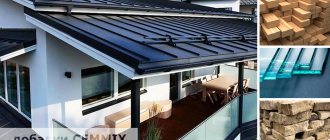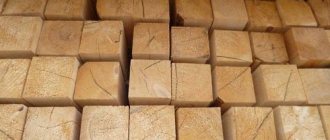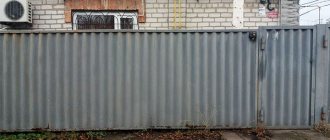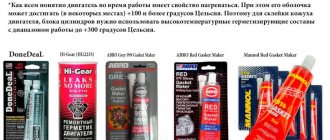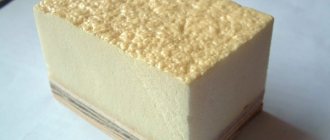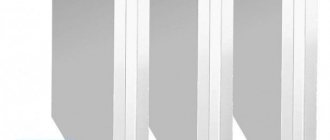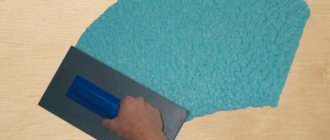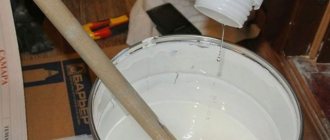A large number of insulating materials are produced. In construction, one of the most harmful factors for the foundation is moisture; to protect various structures from it, it is necessary to create additional protection; often for this purpose, compositions with bitumen are used. The most effective type among these products is rubber-bitumen mastic. Its features will be discussed in detail below.
Features and applications
Rubber-bitumen mastic is distinguished by its main area of application in the form of creating a protective film-type barrier on the surface through which water cannot penetrate. The components of the product are responsible for the characteristics obtained from use. The main element in these mastic substances is most often considered to be petroleum bitumen. The difference from other mastic products, first of all, lies in the different composition, which gives a different level of plastic properties and strength of protection.
Rubber mastic also includes rubber, a thinner and a filling component. These elements play the following role in the composition:
- The rubber and bitumen components help create the required waterproofing of the surface, the first element preventing melting under high temperature exposure and cracking from cold air;
- Fillers are required to supplement the solution with strength characteristics, resistance to ultraviolet radiation and chemical elements;
- A thinner is necessary to make the application process easier; the cold type can be applied simply without the need to warm up the composition. To obtain the desired level of viscosity, you may only need to dilute the solution with a solvent.
Rubber-bitumen mastic is distinguished by its main area of application in the form of creating a protective film-type barrier on the surface through which water cannot penetrate.
What does bitumen mastic consist of?
Mastic is a very plastic material. It has high astringent and waterproofing properties. In addition to bitumen, the main composition of the material contains binding organic substances and mineral additives.
Density, resistance to low external temperatures, and hardness are provided by the following inclusions:
- dusty asbestos;
- special mineral wool;
- brick, quartz and limestone powders;
- ash.
The presence of thickeners such as chalk, peat chips and ground asbestos will guarantee ease of application of mastic, reduced consumption and improved thermal insulation properties of the material.
Special fibrous fillers are responsible for high resistance to bending and reinforcement of the composition. And various polymer components will give the material high waterproofing properties.
Shelf life, consumption and drying time
Bitumen-rubber mastic dries on average in 12-24 hours. But this process is influenced by some surrounding factors. Depending on the fillers, each type may have its own drying time, when the treated surface can be put into operation. The manufacturer writes information about the time on the packaging of the product. Factors influencing the drying rate are as follows:
- Thickness of the layer with which the mastic composition is applied;
- Temperature indicators during this period of time, the level of their change;
- Air humidity;
- Ultraviolet radiation, whether it is directly affected or not;
- The type of base on which the mastic was applied.
The average consumption of a particular substance is also indicated on the mastic packaging, but usually it is 0.5 l/sq.m. m, with a layer thickness of 0.5 mm. The shelf life of mastic compositions is usually 1 year, but it is important to store the products away from heating devices, in a dark place, and there should be no contact with moisture.
Bitumen-rubber mastic dries on average in 12-24 hours.
Methods of applying material
Taking into account the presented classification, it becomes clear that there are two ways to use bitumen material: cold and hot. The material can also be applied mechanically and manually.
The “manual” method involves applying the material using large paint brushes. They should have short and hard pile. To make the work work better, you need to purchase flute brushes. A short-hair seaming roller is also suitable for these purposes. If the roof is being waterproofed, the emulsion must be poured onto the base, leveled with a squeegee and rubbed with a roller.
When using the mechanized method, you must prepare a sprayer with an operating pressure of 150 bar. This apparatus was specially designed for liquid materials. To work, it is necessary to use only those sprayers that have mixing of the components inside.
The video shows bitumen mastic for roof waterproofing with your own hands:
But to learn how to use mastic and apply it, you need to familiarize yourself with the following action plan:
- Before using the mastic, it must be kept in a warm room for a day, and the temperature there should be more than +15 degrees. After this, dilute it with a solvent.
- Prepare the surface to be treated by removing debris, old coating, snow and ice.
- Apply bitumen primer to the base of the roof. This step is very important, especially when applying mastic to a porous surface.
- Dry the floor area. There are mastics that can be used to treat wet surfaces.
- Pour the material onto the roof in a small amount. Using a mop, loosen and then rub the surface with a brush. In those areas where there are joints and abutments where cracks may form, reinforcement will be required.
- Place the fiberglass cloth on the first layer of mastic, and then roll it over.
- When the first layer has dried, apply the second.
Information from the article will help you understand which is the best insulation for roofing.
But the information from the article will help you understand the cost of soffits for roofing.
It will also be interesting to learn about what a Tyvek roofing waterproofing membrane is: https://resforbuild.ru/paneli/krov/gidroizolyaciya/gidroizolyacionnaya-membrana-dlya-krovli.html
Why a waterproofing film for roofing is needed and how to use it correctly is described in this article.
How to prepare the mixture
Rubber-bitumen waterproofing mastic, like polymer and other types, must be prepared before use. When it comes to cold mastic, the process is short-lived. Usually it is enough to mix the composition well and you can apply it. But there are two-component options, then you need to add a solvent before work and mix them thoroughly with the bulk. Adding a diluent may also be necessary for a thickened composition.
The hot type must be heated in a water bath before use. The heating temperature depends on the type of product; proceed according to the instructions from the manufacturer.
The hot type must be heated in a water bath before use.
Manufacturers and prices
Today on the shelves of construction stores you can find bitumen mastic of both Russian and foreign production.
Gidroizol
This material is characterized by high flexibility and water resistance. At elevated temperatures, the coating can last about 2 hours. The service life will be 15 years. And you can buy the material for 320 rubles.
Technique
This manufacturer's product range includes bitumen mastics in a wide variety:
- Mastic for waterproofing foundations and roofs - Technikol 21, MGTN 24, Eureka 41, Bitumen-rubber mastic 20. The cost is 240 rubles.
- To perform waterproofing inside the house - Technikol 31. This mastic is water-based. Cost 280 rubles.
- To protect the coating from sunlight and thermal abrasion, it is necessary to use aluminum mastic 57. The composition of the product contains aluminum pigment, which has reflective properties. Cost 310 rubles.
You may also be interested in learning about what a point aerator for soft roofing is and how and where it is used.
But which hydro-vapor barrier films for roofing are the best are described in great detail in this article.
It will also be interesting to learn about what roofing bitumen tape is and where exactly it should be used.
It will also be interesting to know what the isover standard is and what technical characteristics it has.
But what exactly roll insulation with foil is and where exactly it is used will help you understand the information from this article.
Rastro
This manufacturer produces mastic under two brands:
- Izhora . The range includes bitumen-polymer and hot mastics. The cost is 250-360 rubles.
- Slavyanka . You can purchase cold mastic, which is used for treating roofs and foundations. The cost is 340 rubles.
Bitumen mastic is a reliable and durable material for waterproofing various types of roofs. The secret of the product is that in addition to the main component – bitumen, the composition contains auxiliary ones. It is they who give the material all the necessary waterproofing qualities. So when buying mastic, be sure to read the composition so that you certainly do not make a mistake with your choice.
Precautionary measures
The work requires the master to comply with safety rules. A hot type of mastic paste should only be heated in a water bath; the product should not be placed on an open fire. Heat the solution in the same container in which it was sold. Other rules:
- During the work itself, open fire should also not be allowed;
- The temperature when applying the composition should not be lower than -5 degrees;
- Internal work requires the creation of good ventilation;
- Wear protective clothing, gloves and a respirator.
The temperature when applying the composition should not be below -5 degrees.
Let's sum it up
Bitumen mastic is a waterproofing material based on bitumen, to which various fine powders are added to increase hardness and heat resistance, chalk and ground asbestos or peat chips for thickness, fibrous materials for reinforcement, and polymers for greater elasticity. Hot mastic is produced in briquettes and requires heating to 150-180 °C before use, so it is rarely used, mainly when urgent roof repairs are needed during the rainy season. Cold mastic contains solvents, so it is liquid or paste-like and does not need to be heated. After application, the solvents quickly evaporate and the mastic hardens, forming a plastic and durable coating.
The main purpose for which bitumen waterproofing mastic is needed is to create an airtight coating on flat roofs. In addition, it is used for gluing underlay carpets and soft tile shingles, filling expansion joints, sealing joints and repairing roofs. Before performing work, it is better to keep the mastic for a day in a warm room. It can be applied with a brush, roller, brush, trowel, spatula or spray. It is not advisable to dilute the mastic, but if there is such a need, you need to use white spirit, solvent, kerosene or gasoline. Apply bitumen mastic to a dry surface free of dirt and dust in parallel strips in several thin layers. To strengthen it, fiberglass is placed between the layers, and mineral sand is poured on top of the latter to protect against UV rays.
Possible options for applying bitumen compositions
The process begins by preparing the base. The base must be cleaned of all types of contaminants; when working with metal, rusty areas must be removed. If the material is porous, then a primer layer is applied. You can proceed to applying mastic after the surface has completely dried.
The solution can be applied with a roller, brush or spatula. A 2-3 layer coating is made, the layers should be no thicker than 1-2 millimeters. Each layer must dry thoroughly before applying the next one; drying usually takes 24 hours.
A 2-3 layer coating is made, the layers should be no thicker than 1-2 millimeters.
Rubber-bitumen mastic is a good option to obtain a base protected from moisture. It is important to choose high-quality compounds; it is recommended to request a quality certificate from the seller. When working, precautions are observed; the compositions are toxic and flammable. But you can do the job yourself; the process is not complicated.
Popular manufacturing companies in our market
Well-known brands include TechnoNIKOL, Descartes and KhimTorgProekt. All of them have been on the market for more than 20 years and the reviews are good. I’ll briefly tell you about their rubber and bitumen mastics.
TechnoNIKOL
It produces two special brands: AquaMast (AkvaMast) and TechnoNIKOL No. 20. Both products are completely ready for use, but can be diluted with organic solvents.
Designed for arranging mastic waterproofing of various building structures, as well as repairing any types of roofing, creating protective anti-corrosion layers, etc.
Packaging: metal buckets with a capacity from 3 to 20 liters.
Descartes
It produces cold-curing rubber-bitumen mastic called Expert. It is used for repair and installation of roofing, external waterproofing of various building communications, anti-corrosion protection of metal surfaces and gluing a number of rolled materials.
Packaging: 1.8 kg jar or 18 kg bucket.
Description
Bitumen waterproofing is based on bitumen. It is obtained as a result of the oxidation of residual petroleum products. Since bitumen does not have sufficient natural elasticity and resistance to weathering, when producing bitumen mastic, auxiliary components are introduced into it:
Bitumen mastics can be produced in various forms.
On video - bitumen mastic for roof waterproofing:
It all depends on what components were used in the preparation of the waterproofing material:
Video about roofing mastic, liquid rubber
The material is characterized by elasticity, excellent heat resistance and the ability to withstand temperature changes such as from -35 degrees to +135 degrees. It is used in the repair of mastic roofing and acts as an adhesive when using roofing roll materials and creating waterproofing for buildings and structures.
Polymer mastic is an environmentally friendly and quick-drying water-based bitumen material that is improved with polymers. It is used for waterproofing underground buildings, as well as for sealing wells and sewers. Once applied to the surface, the mastic creates a rubbery, waterproof film that has a long service life.
Sealing rubber mastic is made in the form of a white and thick mass, and it is used to seal cracks, seams, joints and cracks in concrete and reinforced concrete structures. It has adhesion to wood, metal and concrete. After drying completely, the mastic is ready for processing with paints and varnishes.
Fireproof mastic is made in the form of a plastic and viscous mass of a gray shade. It is made from inorganic binder substances with additives in the form of silicate and mineral fillers. This mastic is used to insulate gas ducts and furnaces; it can withstand temperatures up to +1650 degrees.
Sealing non-hardening mastic is a viscous homogeneous mass that consists of several types of rubber, plasticizers and fillers. It is sold in briquettes and used for sealing walls from the outside, as well as for insulating window/door units at the junction with the wall.
Universal mastic looks like a homogeneous mass of various types of fillers and bitumen. Its purpose is to carry out roofing and waterproofing work, creating protection against corrosion of any structures and pipelines. Thanks to its use, you can glue any building materials.
Sound-proofing rubber mastic is presented in the form of a sprayed mass, which has excellent sound-proofing and vibration-absorbing characteristics, and it is made on the basis of an aqueous dispersion of resins of synthetic origin with the addition of anti-inflammatory components.
Butyl rubber mastic is made only from environmentally friendly components and is not subject to rotting processes. Mastic is often used to insulate ventilation systems.
Waterproofing acrylic mastic is the most popular, since when applied to the surface it creates a waterproof film that protects the coating from dampness, mold, and rust. It is very durable, easy to apply, and is only used for sealing indoors.
Two-component polyurethane mastic is a liquid white mass that is odorless and, after application, forms an elastic and strong coating. It is used for waterproofing drinking water tanks, rooms with high humidity levels and water pipes.
Purpose
Easy to apply, cold-curing rubber-bitumen mastic can be used as a waterproofing layer in the automotive and construction industries. Most often, this composition is used in construction; it is in this area that it is in greatest demand.
Rubber-bitumen mastic is successfully used for waterproofing structures with various purposes and consisting of a variety of materials. It equally well protects both concrete elements of the foundation, walls, and wooden beams used as a frame base for structures.
In addition, it is successfully used as anti-corrosion protection for metal surfaces, such as pipelines, steel containers for various purposes and other metal structures.
The excellent waterproofing properties of mastic make it possible to use the composition for repairing flat roofs. The roofing mixture is specially designed for covering roofs; its resistance to moisture does not allow mold to form on the surface, thereby preventing its premature destruction.
The sealing function inherent in the rubber-bitumen mixture allows the composition to also be used as a filler for seams, cracks, chips and other depressions in building materials without dismantling old layers. In addition, it can be used to glue various waterproofing materials.
Non-hardening mastic is used as a sealant in the joints between a window or door block and a wall.
In the automotive industry, rubber-bitumen mastic is successfully used in many types of body work. Processing the bottoms and arches of the car can increase their impact resistance. But the main function of mastic is still anti-corrosion protection of these places that are most vulnerable to water.
Adding aluminosilicates to the rubber-bitumen composition allows you to increase the sound insulation characteristics of the car.
The material in question has a number of advantages:
- high degree of protection against dampness and mold;
- using mastics you can create a seamless coating that has no joints; good strength;
- ability to withstand high and low temperatures. In regions with prolonged exposure to negative temperatures, bitumen mastic with the addition of M50 class oil is used, but if polymer fillers are added to the material, it can withstand significant negative temperatures (up to -50º).
One of the important aspects of working with mastic is its drying time. This property of a material to evaporate excess moisture is affected by ambient temperature and humidity. In general, it is recommended to work with hot mastic in the temperature range from +5 to 35 degrees, but this is not always possible.
This mastic dries from 6 hours to a day from the time of application to the surface - the drying time depends on the temperature, humidity and raw material composition of the material. If waterproofing work is carried out at subzero temperatures, then it is recommended to add accelerator A-3000 to the mastic composition, proportion 1 to 25, which will allow polymerization of the material.
Bitumen rubber mastic and its consumption per 1 m2
It will not be possible to make an estimate in advance, plan work and carry out other work if you do not know how much material is required per 1 m2. To determine the consumption of mastic, it will be easiest for you to look at the label, but if it does not have such data, then you can find a note indicating the recommended minimum material for coating with one layer. This way it will be quite easy to calculate how much mastic you will need. Typically, this material consists of 35-70% volatile solvents, which means that the same percentage is inherent in the shrinkage of the bitumen composition after application.
| Foundation waterproofing | From 2.1 to 3 kg/m2 |
| Roof arrangement | From 3.6 to 6.1 kg/m2 |
| Attaching roofing felt | From 1.1 to 2.1 kg/m2 |
Bituminous waterproofing GOST
Various waterproofing and roofing bitumen products have uniform standards and technical conditions that determine the following points:
- Requirements for raw materials and materials;
- Marking;
- Package;
- Safety requirements;
- Acceptance rules.
On our website you can download the current edition of the relevant GOST standards by clicking on the following link - Waterproofing mastics GOST 30693-2000.
Ways to speed up the drying of mastic
In practice, there are cases when the lack of time for construction work does not allow a long wait for the mastic to dry. In this case, experts resort to fairly simple but effective ways to speed up this process.
Thus, to quickly evaporate the solvent in the mastic composition, notched spatulas are used when applying it. A layer of mastic applied in this way, due to the presence of grooves and therefore an increase in the evaporation area, dries much faster without significant losses in the quality of the result.
After applying mastic to the surface to be treated, it is necessary to isolate the work site from possible moisture on the surface and protect it from mechanical damage. This will ensure uniform drying of the layer without changes in its thickness.
In the case of processing objects or surfaces that are not outdoors, but indoors, you can use various forced heating systems (heat guns, heaters, etc.), which will significantly speed up the drying process of the mastic. However, in these cases, it is important to follow fire safety rules and eliminate as much as possible the possibility of people being in this room, since the vapors released can cause significant damage to human health.
It should be noted that the duration of drying of mastics can also be influenced by the shelf life of this material in the packaging.
Drying time of various types of mastics
Despite the fact that bitumen mastics are produced according to uniform state standards, their drying time may vary . This indicator, in addition to the external factors described above, can also be influenced by the presence of various bases, additives and impurities in the composition of the mastic. For example, rubber bitumen mastic, which is used mainly in the automotive repair industry, has a shorter drying time, which can range from 12 to 24 hours . Bitumen-rubber mastic of the "Universal" brand has a longer drying time - 24 hours .
One of the most popular brands of waterproofing mastics, “Gidroizol,” dries within 24-48 hours after its application . TechnoNIKOL brand mastics harden within 24 hours after treating surfaces with them.
Areas of use
Rubber mastic is a practical product that is used at all stages of building a house with your own hands. Affordable price, economical consumption, and wide possibilities of use make rubber bitumen a sought-after product in any hardware store. Bitumen mastics are suitable for the following work:
Experienced craftsmen recommend that when choosing a mastic, pay attention to the average consumption of the mixture, service life, flexibility when exposed to low temperatures and adhesion strength. Bitumen-polymer compositions, which have high adhesive ability, elasticity and last more than 10-15 years, are considered optimal in terms of quality and price.
How to apply mastic?
Bitumen mastic can be applied manually, that is, with a brush or roller, or mechanically, for example, using a special air sprayer.
Both application methods are quite technologically advanced and provide an excellent opportunity to carry out work related to the roofing device, quite simply and quickly, regardless of the angle of inclination of the roofing surface. This is clearly noticeable when installing a roof, which has a huge number of different elements and connections.
When covering pipes, load-bearing structures, shaft roofs, etc., it is necessary to spend a lot of time and effort cutting out rolled material, while mastic makes it possible to make exactly the same even coating, but much easier and faster, which is why mastic prevails over rolled materials.
Application area
We supply bituminous rubber mastic wholesale to both private consumers and customers working on the construction of large projects. This is due to the wide range of applications. Mastic is used for: • waterproofing surfaces during the construction of structures made of any material; • installation of a new or restoration of an old roof. The use of hot mastic can provide not only waterproofing, but also effective insulation in conditions of aggressive soil conditions. Bitumen-rubber mastic MBR-90 provides a high-quality waterproof barrier for structures made of wood, concrete, and other materials. As an anti-corrosion agent that masks minor metal damage, this mastic is also suitable for treating the undersides of cars.
